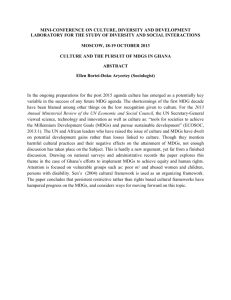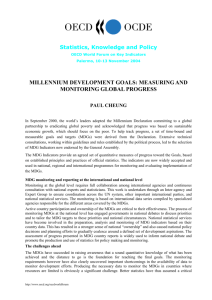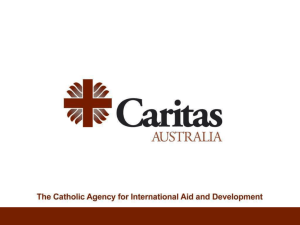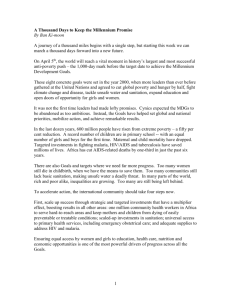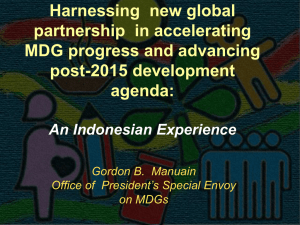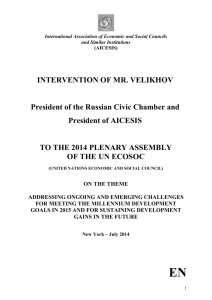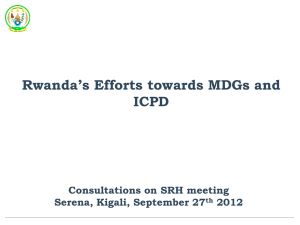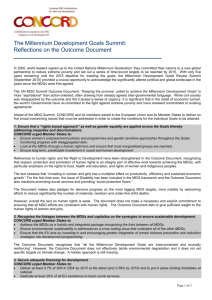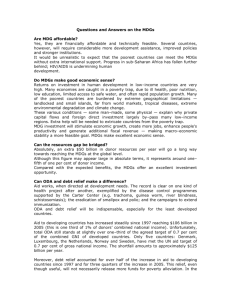Similarities and complementarities between MDGs and
advertisement
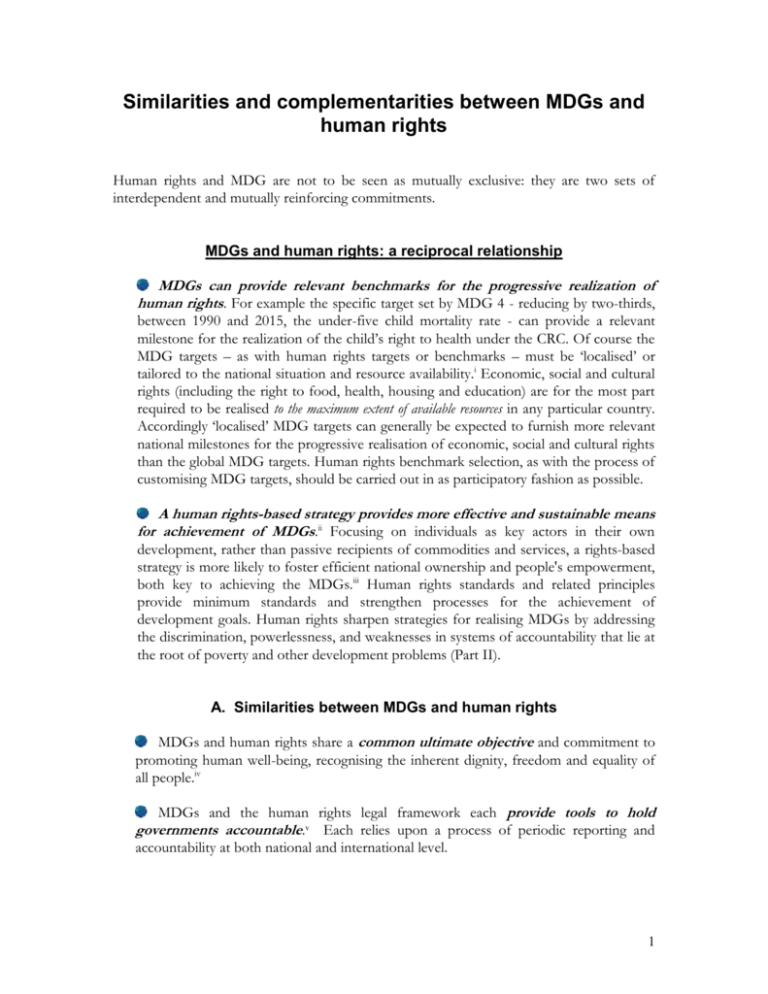
Similarities and complementarities between MDGs and human rights Human rights and MDG are not to be seen as mutually exclusive: they are two sets of interdependent and mutually reinforcing commitments. MDGs and human rights: a reciprocal relationship MDGs can provide relevant benchmarks for the progressive realization of human rights. For example the specific target set by MDG 4 - reducing by two-thirds, between 1990 and 2015, the under-five child mortality rate - can provide a relevant milestone for the realization of the child’s right to health under the CRC. Of course the MDG targets – as with human rights targets or benchmarks – must be ‘localised’ or tailored to the national situation and resource availability.i Economic, social and cultural rights (including the right to food, health, housing and education) are for the most part required to be realised to the maximum extent of available resources in any particular country. Accordingly ‘localised’ MDG targets can generally be expected to furnish more relevant national milestones for the progressive realisation of economic, social and cultural rights than the global MDG targets. Human rights benchmark selection, as with the process of customising MDG targets, should be carried out in as participatory fashion as possible. A human rights-based strategy provides more effective and sustainable means for achievement of MDGs.ii Focusing on individuals as key actors in their own development, rather than passive recipients of commodities and services, a rights-based strategy is more likely to foster efficient national ownership and people's empowerment, both key to achieving the MDGs.iii Human rights standards and related principles provide minimum standards and strengthen processes for the achievement of development goals. Human rights sharpen strategies for realising MDGs by addressing the discrimination, powerlessness, and weaknesses in systems of accountability that lie at the root of poverty and other development problems (Part II). A. Similarities between MDGs and human rights MDGs and human rights share a common ultimate objective and commitment to promoting human well-being, recognising the inherent dignity, freedom and equality of all people.iv MDGs and the human rights legal framework each provide tools to hold governments accountable.v Each relies upon a process of periodic reporting and accountability at both national and international level. 1 Overall resource constraints are relevant to the pace of realisation of both MDGs and human rights. As already seen, economic, social and cultural rights are – for the most part – required to be realized progressively, to the maximum extent of available resources, and monitored over time. There are similarities in the guiding principles for the realization of both MDGs and human rights, notably in connection with: participation, empowerment, national ownership and the importance of partnerships. Human rights standards are nationally owned, establishing minimum standards for participation, empowering people as actors for human development. Partnerships at all levels – local, national and international – are necessary for effective implementation of human rights obligations. Similarly, the customising of MDG targets at country level should take place through a broad-based and inclusive dialogue and debate. MDG reporting and monitoring at the sub-national level provides the opportunity to take the MDGs to community level, helping to strengthen ownership and empower people to better articulate their local needs within the framework of a nationally and internationally agreed development agenda.vi B. Complementarities between MDGs and human rights MDGs and human rights have different but complementary purposes. MDGs are a set of numerical targets established for the purpose of raising awareness among the public, and for social mobilization. The fact that the MDGs are small in number, quantifiable and time-bound facilitates the simplicity and clarity of key messages. By contrast, the international human rights framework embodies a more extensive international consensus on the minimum prerequisites for a life of dignity, with more comprehensive and specific performance standards. For example MDG 3 highlights just a few of the essential aspects of ‘gender equality and empowerment,’ namely, parity in enrollment rates in primary and secondary education. But this should not be taken as excluding the many inter-related human rights facets of gender empowerment strategies, including equality of opportunity in employment and exploring structural barriers to women’s participation in public life. Universality v. developing country focus. The MDGs are focused upon a number of priority development issues which are particularly relevant for developing countries. International human rights standards are of comprehensive content and universal application, applicable equally to all people in all countries. MDGs are mainly quantitative (defined numerical targets), whereas human rights also reflect explicit qualitative dimensions. Whereas MDG 1 targets at halving the proportion of people who suffer from hunger between 1990 and 2015, implementing the right to food does not only encompass the right of every individual to be free from hunger. It, in addition, requires food to be of adequate nutritional value, culturally appropriate and safe – three qualitative dimensions of the right to food.vii 2 Human rights standards are matters of legal obligation. While MDGs and human rights standards share a common aim of strengthening government accountability for results, the performance standards established by the human rights framework are legally binding. These standards help to identify ‘no go areas’ (for example, the deliberate or arbitrary retrogression of some rights at the expense of others) and unacceptable policy trade-offs in the development equation. However, human rights are not ‘trumps’ in all situations, and can not be expected to reveal clear solutions to all development problems. Institutions and mechanisms of accountability. Accountability for MDG realization lies principally at the political level, through the preparation of periodic progress reports, national and international campaigns, and the mobilisation of public opinion. Accountability for human rights realization is backed by a different and broader range of institutions and mechanisms at national level (including courts, national human rights institutions, informal or community-based mechanisms) and international level (including the treaty bodies). Dealing with disparities. At the global level, the MDGs are based upon ‘average’ attainments. While they give a good sense of overall progress, average numbers can be misleading.viii Improvements on the average number of years of school attendance in a country can, for example, be the result of dramatic improvement in access to education for girls from privileged groups, with a slight reduction in years of schooling only for the poorest. Similarly, apparent improvements in per capita income do not necessarily reflect an improvement in poverty reduction; they can even hide an increase in income inequality and absolute poverty.ix By contrast the human rights framework compels us more immediately and explicitly towards the eradication of discrimination and the prioritisation of action in favour of the poor, vulnerable and marginalized. Pursuing equity and narrowing disparities within countries – along gender, ethnic, racial and geographic lines – consequently requires looking behind country averages. MDG Reports and national campaigns need to find a workable balance between this concern and the practical need to keep messages clear and simple. MDG 3 (gender equality) should be seen as an integral and cross-cutting element of strategies for achievement of all MDGs, with data disaggregated accordingly.x Process and outcomes. Consistent with their limited purpose, the dominant focus of the MDGs is upon poverty reduction outcomes. Within the human rights framework, process is equally important as outcomes. While there are some commonalities, noting for example the need for popular participation for localising MDGs and for effective campaigning, human rights standards establish baselines (even if not blueprints) for meaningful and informed participation in policy making, along with criteria for inclusive and sustained progress, and accessible means of redress in the event that human rights standards are violated. Rights-based strategies for MDG realisation. Rights-based strategies for MDG realisation recognize people as key actors for their own development, rather than passive recipients of commodities and services, treating poverty reduction as a matter of entitlement 3 (and correspondingly, obligation) rather than discretion or charity. Human rights empower people to make claims against those with a duty to respond, strengthening accountability for development outcomes. Rights-based strategies for MDG realization seek to identify the immediate, underlying and basic causes of development problems. As such, they reveal structural constraints impeding human development, a factor too often overlooked in the past. Finally, rights-based MDG realization uses in synergy both top-down and bottom-up approaches in which strategic partnerships are developed and sustained.xi ‘The [MDGs] reflect a human rights agenda – rights to food, education, health care and decent living standards. The need to ensure all these rights confers obligations on the governments of countries both rich and poor.’ UNDP, Human Development Report 2003, p.29. i UNDG, Country Reporting on the Millennium Development Goals: Second Guidance Note, September 2003, p.9. Cf. UNDP, Poverty Reduction and Human Rights, A Practice Note, June 2003 confirming this in contexts where injustices and discrimination are the main reasons for poverty. iii Human Development Report 2003, pp. 1 and 30 et.seq. iv Human Development Report 2003, p. 27. Box 1.1. shows how MDGs, human development and human rights share a common motivation, p. 28. v See for example Human Development Report 2003, p. 133: "Implementing the policies and interventions required to meet the Millennium Development Goals requires the commitment of political leaders. But it also requires sustained political pressure, broad popular support and mechanisms for delivering services effectively. An open democratic state that guarantees civil and political freedoms is essential for such popular mobilization and participatory civic engagement, so that poor people can pressure their leaders to deliver on their commitments to the Goals." ii vi UNDG, Country Reporting on the Millennium Development Goals: Second Guidance Note, September 2003, p.9. vii Committee on Economic, Social and Cultural Rights, General Comment No. 12 (Article 11 ICESCR, the right to adequate food), UN Doc. E/C.12/1999/5. viii Vandemoortele, Jan. Are the MDGs feasible? in Targeting development: Critical perspectives on the Millennium Development Goals and International Development Targets, Richard Black & Howard White (eds.), Routledge, (forthcoming). ix The 2003 Human Development Report, referring to Brazil, India, China and Mexico, affirms that "the spirit of the Goals is not met if countries that cross the finishing line leave behind many poor people". Human Development Report 2003, p. 34. In fact, it concludes that "many countries with good average performance on the Goals contain population groups – and sometimes entire areas – being left behind", p. 46. Cf. also the concept of "ruthless growth" used in past Human Development Reports, p. 67 and Vandemoortele (forthcoming). x UNDG, Country Reporting on the Millennium Development Goals: Second Guidance Note, September 2003, p.7. For an authoritative statement on the basic elements of what has become known as a ‘rights-based approach’ to development cooperation, see the report of the ‘Second Inter-agency Workshop on Implementing a Rights-based Approach in the Context of U.N. Reform,’ held in Stamford, USA, in May 2003, available at http://www.undg.org. Attachment 1 of the report is a Statement of Common Understanding on a Rights-based Approach to Development Cooperation, the main elements of which are reflected in the foregoing discussion concerning the complementarities between MDGs and human rights and how the latter can strengthen strategies for the achievement of the former. xi 4
